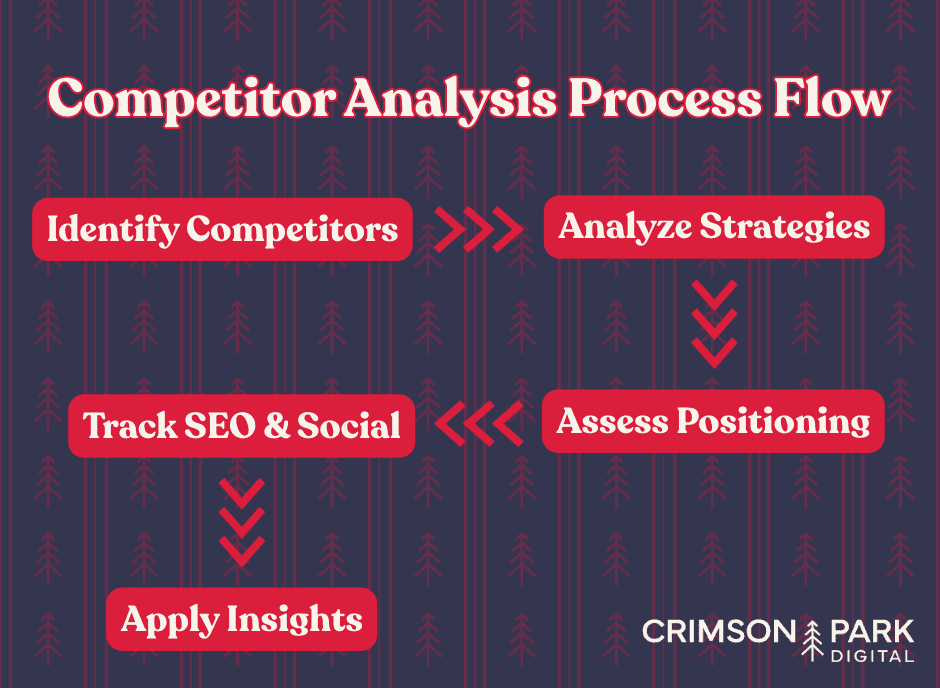Whether you’re a local restaurant, a boutique hotel, a B2B brand, or a mixed-use property trying to attract tenants and visitors, understanding how competitors play their cards gives you a serious edge. It’s less about copying and more about decoding their playbook to find your own winning moves.
What Is Competitor Analysis, Anyway?
Competitor analysis is simply looking at your competitors’ strengths and weaknesses and comparing them to your own. Who’s doing what? What’s resonating with customers? Where are they overreaching, and where are they leaving gaps you could fill?
For businesses focusing on local markets, this intel is priceless. It gives insight into local trends, customer preferences, and even seasonal opportunities that bigger national brands might miss.

The bonus: competitor analysis isn’t just reactive. It’s forward-looking. Tracking what your competitors do today can help you anticipate tomorrow’s market shifts and get a jump on new trends before anyone else does.
Step 1: Identify Your Key Competitors
Not all competitors are created equal. Start by mapping out:
- Direct competitors: Brands offering the same products or services in your area.
- Indirect competitors: Businesses solving the same customer problem in a different way.
- Emerging competitors: New players who could shake things up if left unchecked.
For example, a hotel in Charleston isn’t just competing with other hotels. They’re also competing with Airbnb hosts, event venues, and even local B&Bs for attention and bookings. Spotting these indirect players early can give you a huge advantage.
Step 2: Analyze Competitor Strategies
Once you know who you’re watching, dig into what they’re actually doing.
- What social media platforms do they dominate?
- How are they engaging with customers?
- What kind of content gets likes, shares, and comments?
- How often are they posting? Timing can be everything.
These insights can guide your own content strategy. For instance, if your competitor’s TikTok posts are racking up thousands of views while Instagram is falling flat, maybe TikTok deserves more of your attention.
Real-world example: CPD helped a local hotel revamp its social media strategy to highlight the guest experience, showcase seasonal offerings, and share local stories. The refreshed approach boosted audience engagement, expanded reach, and strengthened the hotel’s connection with its community.
Step 3: Assess Market Positioning
Understanding how competitors position themselves helps you find your own voice. Check out:
- Branding: How do they look and feel online?
- Messaging: What’s their tone, style, and value proposition?
- Pricing: Are they premium, mid-tier, or budget-friendly?
Tracking shifts in their positioning can also highlight opportunities. Maybe a competitor is pushing discounts; time to highlight your unique experience instead. Or maybe they’re ignoring a particular local audience that your brand can win over.
Real-world example: A mixed-use property in Charlotte used competitor positioning data to feature local shops and events that weren’t highlighted by nearby properties, instantly carving out a unique identity.
Step 4: Leverage Digital Tools
Top agencies don’t guess; they use data. Tools like SEMrush, Ahrefs, and Moz reveal competitor keywords, backlinks, and web traffic trends. Social listening tools like Sprout Social or Hootsuite track engagement, brand mentions, and sentiment.
Why it matters: You can see not just what competitors are doing, but how well it’s working. Then, you can tweak your own campaigns to outperform them without blindly copying.
Step 5: Get Smart with SEO and AI-Driven Search
Keywords still matter, but today it’s about more than just tracking single words. AI-driven search and natural language processing mean search engines are looking for context, phrasing, and the way people naturally ask questions.
Understanding how competitors are organically visible in both traditional and AI-powered search can uncover opportunities that simple keyword tracking misses.
Here’s what to focus on:
- On-page SEO: Are they optimizing for local searches? Are they answering questions your audience actually types into Google or asks via AI search assistants?
- Off-page SEO: Who’s linking to them, and who could link to you? Backlinks still matter, but think strategically about relationships and local mentions.
- Content gaps: What questions aren’t they answering? Are there topics or natural phrases your audience is searching for that competitors are missing?
Real-world example: A healthcare brand revamped its content strategy to focus on the questions patients and local audiences were actually asking. This approach came from analyzing competitors’ content and spotting gaps in what was being answered. By creating content optimized for these natural search phrases, the brand increased organic traffic, improved local visibility, and became a trusted resource for its community.
Step 6: Spy on Social Media
Social platforms are a goldmine for competitive insights. Look at:
- Types of posts that get the most engagement
- Customer interactions: How are they responding to questions and complaints?
- Brand voice: Does their tone resonate with the audience?
Real‑world example: When working with a locally rooted farm-to-table brand in Charlotte, CPD sharpened its Instagram strategy to lean into storytelling, chef spotlights, and community-driven posts. Instead of running down-budget ads or gimmicks, we leaned into content that felt genuine; a strategy we identified by analyzing competitors’ engagement patterns and spotting what worked (and what didn’t) in the local market.

Step 7: Collect, Analyze, Apply
Competitor analysis isn’t one-and-done. Here’s the approach:
- Data Collection: Scrape websites, social media, reviews, and industry reports.
- Data Analysis: Spot trends, patterns, and opportunities. What’s working? What’s failing?
- Strategic Application: Decide which tactics fit your brand, what to improve, and what to ignore.
Strategic marketing agencies often combine local and national competitor intel to craft campaigns that resonate deeply with target audiences.
Why Competitor Insights Work
Competitor analysis is more than a numbers game. It’s a strategic blueprint. Any brand can uncover:
- Untapped local audiences
- Content opportunities competitors missed
- Unique messaging angles
- Smart campaign timing
It’s about making moves that feel effortless to your audience but are backed by research and insight.
Turn Competitor Insights into Real Results
Competitor analysis isn’t just for agencies or marketing gurus. It’s your secret playbook for spotting opportunities, staying agile, and making smarter moves in your local market. Whether you run a restaurant, head marketing at a multi-location healthcare brand, manage a boutique hotel, or oversee a mixed-use property, decoding your competitors’ strategies helps you carve out your space, grow your audience, and make your mark.

Ready to take the guesswork out of your marketing? Crimson Park Digital can help you turn competitor insights into actionable strategies that drive growth and visibility. Reach out today and see how we can help your brand win locally and beyond.


